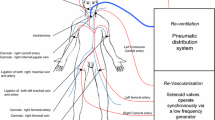Abstract
A training system with quantitative evaluation of performance for training perfusionists is valuable for preparation for rare but critical situations. A simulator system, ECCSIM-Lite, for extracorporeal circulation (ECC) training of perfusionists was developed. This system consists of a computer system containing a simulation program of the hemodynamic conditions and the training scenario with instructions, a flow sensor unit, a reservoir with a built-in water level sensor, and an ECC circuit with a soft bag representing the human body. This system is relatively simple, easy to handle, compact, and reasonably inexpensive. Quantitative information is recorded, including the changes in arterial flow by the manipulation of a knob, the changes in venous drainage by handling a clamp, and the change in reservoir level; the time courses of the above parameters are presented graphically. To increase the realism of the training, a numerical–hydraulic circulatory model was applied. Following the instruction and explanation of the scenario in the form of audio and video captions, it is possible for a trainee to undertake self-study without an instructor or a computer operator. To validate the system, a training session was given to three beginners using a simple training scenario; it was possible to record the performance of the perfusion sessions quantitatively. In conclusion, the ECCSIM-Lite system is expected to be useful for perfusion training, since quantitative information about the trainee's performance is recorded and it is possible to use the data for assessment and comparison.
Similar content being viewed by others
References
T Kazui H Osada H Fujita (2006) ArticleTitleThoracic and cardiovascular surgery in Japan during 2004 Jpn J Thorac Cardiovasc Surg 54 IssueID8 363–385 Occurrence Handle16972646 Occurrence Handle10.1007/s11748-006-0008-x
OF Jenkins R Morris JM Simpson (1997) ArticleTitleAustralasian perfusion incident survey Perfusion 12 IssueID5 279–288 Occurrence Handle9300472 Occurrence Handle1:STN:280:DyaK2svksFGrtQ%3D%3D
S Ninomiya A Kinukawa K Itagaki S Takei S Fukunaga C Uyama T Sueda (2004) ArticleTitleDevelopment of a practical simulator system for training the operation of extracorporeal circulation equipments JBME 42 304
Takei S. Development of extracorporeal circulation training system. Master's Thesis, Graduate Course in Integrated Human Sciences, Hiroshima International University, Hiroshima, 2004
Sueda T, Ninomiya S. Extracorporeal circulation training system and programs. Japanese patent 2005-114765, 2005
JB Cooper VR Taqueti (2004) ArticleTitleA brief history of the development of mannequin simulators for clinical education and training Qual Saf Health Care 13 IssueIDSuppl 1 i11–i18 Occurrence Handle15465949 Occurrence Handle10.1136/qshc.2004.009886
FC Forrest MA Taylor K Postlethwaite R Aspinall (2002) ArticleTitleUse of a high-fidelity simulator to develop testing of the technical performance of novice anaesthetists Br J Anaesth 88 IssueID3 338–344 Occurrence Handle11990263 Occurrence Handle10.1093/bja/88.3.338 Occurrence Handle1:STN:280:DC%2BD383kvF2ksw%3D%3D
FM Colacino M Arabia GA Danieli F Moscato S Nicosia F Piedimonte P Valigi S Pagnottelli (2005) ArticleTitleHybrid test bench for evaluation of any device related to mechanical cardiac assistance Int J Artif Organs 28 IssueID8 817–826 Occurrence Handle16211532 Occurrence Handle1:STN:280:DC%2BD2MrjsFSnsg%3D%3D
G Ferrari M Kozarski C De Lazzari K Gorczynska R Mimmo M Guaragno G Tosti M Darowski (2003) ArticleTitleModelling of the cardiovascular system: development of a hybrid (numerical–physical) model Int J Artif Organs 26 IssueID12 1104–1114 Occurrence Handle14738194 Occurrence Handle1:STN:280:DC%2BD2c%2FjvValtw%3D%3D
S Hayashi (1991) ArticleTitleStudy on circulatory assist by combined use of left ventricular assist device with intra-aortic balloon pumping for heart failure Med J Hiroshima Univ 39 IssueID1 15–28
T Masuzawa Y Fukui (1989) ArticleTitleCardiovascular system simulator to use in the field of medical education Technical Report of IEICE MBE89 IssueID8 51–58
N Saied (2005) ArticleTitleVirtual reality and medicine – from the cockpit to the operating room: are we there yet? Mo Med 102 IssueID5 450–455 Occurrence Handle16259396
MA Seropian (2003) ArticleTitleGeneral concepts in full-scale simulation: getting started Anesth Analog 97 1695–1705 Occurrence Handle10.1213/01.ANE.0000090152.91261.D9
AK Wong (2004) ArticleTitleFull-scale computer simulators in anesthesia training and evaluation Can J Anesth 51 IssueID5 455–464 Occurrence Handle15128631 Occurrence Handle10.1007/BF03018308
R Aggarwal S Undre K Moorthy C Vincent A Darzi (2004) ArticleTitleThe simulated operating theatre: comprehensive training for surgical teams Qual Saf Health Care 13 IssueIDSuppl 1 i27–i32 Occurrence Handle15465952 Occurrence Handle10.1136/qshc.2004.010009
SB Issenberg WC McGaghie IR Hart JW Mayer JM Felner ER Petrusa RA Waugh DD Brown RR Safford IH Gessner DL Gordon GA Ewy (1999) ArticleTitleSimulation technology for health care professional skills training and assessment JAMA 282 IssueID9 861–866 Occurrence Handle10478693 Occurrence Handle10.1001/jama.282.9.861 Occurrence Handle1:STN:280:DyaK1MvgsFOqug%3D%3D
JM Beaubien DP Baker (2004) ArticleTitleThe use of simulation for training teamwork skills in health care: how low can you go? Qual Saf Health Care 13 IssueIDSuppl 1 i51–i56 Occurrence Handle15465956 Occurrence Handle10.1136/qshc.2004.009845
RW Morris LM Watterson RN Westhorpe RK Webb (2005) ArticleTitleCrisis management during anaesthesia: hypotension Qual Saf Health Care 14 e11 Occurrence Handle15933284 Occurrence Handle10.1136/qshc.2002.004440 Occurrence Handle1:STN:280:DC%2BD2M3ovVGhtA%3D%3D
SL Dawson S Cotin D Meglan DW Shaffer MA Ferrell (2000) ArticleTitleDesigning a computer-based simulator for interventional cardiology training Catheter Cardiovasc Interv 51 IssueID4 522–527 Occurrence Handle11108693 Occurrence Handle10.1002/1522-726X(200012)51:4<522::AID-CCD30>3.0.CO;2-7 Occurrence Handle1:STN:280:DC%2BD3M%2FosFymtw%3D%3D
S Abrahamson JS Denson RM Wolf (1969) ArticleTitleEffectiveness of a simulator in training anesthesiology residents Med Edu 44 515–519 Occurrence Handle1:STN:280:DyaF1M3hvVGqtQ%3D%3D
Author information
Authors and Affiliations
Corresponding author
Rights and permissions
About this article
Cite this article
Ninomiya, S., Tokumine, A., Yasuda, T. et al. Development of an educational simulator system, ECCSIM-Lite, for the acquisition of basic perfusion techniques and evaluation. J Artif Organs 10, 201–205 (2007). https://doi.org/10.1007/s10047-007-0396-x
Received:
Accepted:
Published:
Issue Date:
DOI: https://doi.org/10.1007/s10047-007-0396-x




